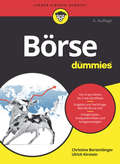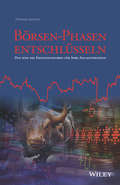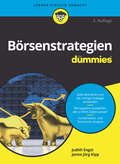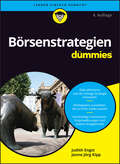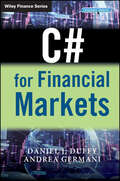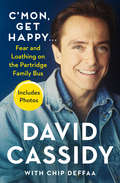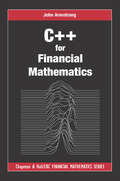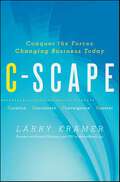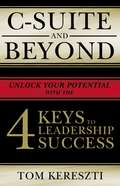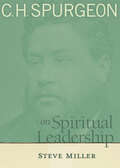- Table View
- List View
Börse für Dummies (Für Dummies)
by Ulrich Kirstein Christine BortenlängerWie funktioniert eigentlich eine Börse und vor allem: Wie kann ich sie als Otto Normalverbraucher nutzen, um mein Erspartes zu vermehren? Dr. Christine Bortenlänger, Geschäftsführender Vorstand des Deutschen Aktieninstituts, und Ulrich Kirstein, Pressereferent der Bayerische Börse AG, erklären in diesem Buch Grundlegendes zu Angebot und Nachfrage an der Börse und stellen die unterschiedlichen Anlageformen vor: Aktien, Derivate, Zertifikate, festverzinsliche Wertpapiere, Fonds & Co. Sie zeigen, wo Sie sich die nötigen Informationen beschaffen können, um eine kluge Anlagestrategie zu entwickeln, die je nach Risikobereitschaft ganz unterschiedlich aussehen kann.
Börse für Dummies (Für Dummies)
by Ulrich Kirstein Christine BortenlängerWie funktioniert eigentlich eine Börse und vor allem: Wie kann ich sie als Otto Normalverbraucher nutzen, um mein Erspartes zu vermehren? Dr. Christine Bortenlänger, Geschäftsführender Vorstand des Deutschen Aktieninstituts, und Ulrich Kirstein, Pressereferent der Bayerische Börse AG, erklären in diesem Buch Grundlegendes zu Angebot und Nachfrage an der Börse und stellen die unterschiedlichen Anlageformen vor: Aktien, Derivate, Zertifikate, festverzinsliche Wertpapiere, Fonds & Co. Sie zeigen, wo Sie sich die nötigen Informationen beschaffen können, um eine kluge Anlagestrategie zu entwickeln, die je nach Risikobereitschaft ganz unterschiedlich aussehen kann.
Börsen-Phasen entschlüsseln: Das sind die Erfolgsfaktoren für Ihre Anlagestrategie
by Hartmut JaenschWie können Sie als Anleger die Börse durchschauen? Wie erkennen Sie den richtigen Zeitpunkt für den Kauf oder Verkauf von Aktien? Und wie sicher können Sie Ihr Geld anlegen? Hartmut Jaensch zeigt, dass die Börse zwar unvorhersehbar, aber keineswegs unberechenbar ist. Der Gründer von prediqma - Institut für Börsenstrategie eröffnet Ihnen seine Erkenntnisse aus 3 Jahrzehnten Forschung zum Kapitalmarkt: Anleger können ablesen, warum Kennzahlen-Analysen und Prognosemodelle in der Finanzkrise versagten. Sie lernen, wie sie risikoarm in Aktien anlegen und wann sich eine Geldanlage lohnt. Jaensch beleuchtet dabei auch die Bedeutung negativer Zinsen für die Aktienmärkte und entzaubert Börsencrash-Prognosen. Sicher an der Börse investieren Dieses Buch basiert nicht auf Hypothesen, sondern auf belegten Fakten. Es weist den Weg, wie Sie Ihr Aktienvermögen und Ihre Rendite auch bei unvorhersehbaren Veränderungen der Aktienkurse schützen und erfolgreich in Wertpapiere investieren. Mehr als nur Aktien-Analyse Unzufrieden mit vagen Handlungsanweisungen begann Hartmut Jaensch schon im Studium Algorithmen zu testen, um Börsenzyklen zu entschlüsseln. Während seiner Tätigkeit als Manager und Berater für Konzerne wie Google, Xerox, Avaya und Dresser forschte er weiter. Unter anderem verantwortete er die Entwicklung von Prognose-, Finanz- und Risk-Management-Systemen. Seine Erkenntnisse aus 30 Jahren Forschung mit Daten aus mehr als 100 Börsenjahren stellt er online mit prediqma auch privaten Anlegern bereit.
Börsenstrategien für Dummies (Für Dummies)
by Judith Engst Janne KippDie Börse bietet tausend Möglichkeiten und zugleich auch große Risiken. Längst ist erwiesen: Börsenerfolg haben vor allem Menschen mit einer cleveren Anlagestrategie. Judith Engst und Janne Jörg Kipp helfen Ihnen in diesem Buch, Ihre persönliche Börsenstrategie zu entwickeln und Ihr Geld strategisch geschickt anzulegen. Sie zeigen Ihnen, wie Sie im unübersichtlichen Dschungel der Börse die richtigen Anlageentscheidungen treffen, und geben Ihnen konkrete Tipps, wie Sie Ihre eigenen Ziele definieren und auf Sie zugeschnittene Pläne für den Vermögensaufbau entwickeln.
Börsenstrategien für Dummies (Für Dummies)
by Judith Engst Janne KippMoney, money, money … Die Börse birgt Chancen, aber auch Risiken. Eine clevere Anlagestrategie ist daher Ihr Schlüssel zum Börsenerfolg. Judith Engst und Janne Jörg Kipp helfen Ihnen in diesem Buch, Ihre persönliche Börsenstrategie zu entwickeln und Ihr Geld strategisch geschickt anzulegen. Sie zeigen Ihnen, wie Sie den Überblick im unübersichtlichen Dschungel der Börse behalten, und geben Ihnen konkrete Tipps, wie Sie Ihre eigenen Ziele definieren, auf Sie zugeschnittene Pläne für den Vermögensaufbau entwickeln und mit welchen wertvollen Zusatztipps Sie als Anleger viel Geld sparen können. Sie erfahren Wie Sie Ihre Vermögensziele definieren und systematisch erreichen Welche Anlageformen die Börse neben Aktien bietet Was Kennzahlen, Charts und Stimmungsindizes Ihnen über die Entwicklung Ihrer Wertpapiere sagen Welche raffinierten Renditestrategien es gibt
Bürgerbeteiligung an der Verwaltung am Beispiel der Hamburgischen Deputationen: Veraltete Beteiligungsform oder bewährtes Mitwirkungsinstrument
by Stephan MeynDieses Buch beleuchtet das althergebrachte Verwaltungsgremium der Hamburgischen Deputationen im verwaltungswissenschaftlichen, historischen, rechts- sowie politikwissenschaftlichen Kontext. Als zentrale Frage wird untersucht, ob die Deputationen in ihrer bis zum Ende der 21. Legislaturperiode bestehenden Form ihre Daseinsberechtigung hatten, welchen historischen Ursprungs sie waren, welchen Reformbedarf es gab und ob sie der Verfassungsvorgabe in Artikel 56 der Hamburgischen Verfassung (a. F.), das Volk an der Verwaltung mitwirken zu lassen, entsprachen. Hierzu wird einerseits eine umfassende quantitative Erhebung mit Hilfe eines standardisierten Fragebogens unter den Deputierten durchgeführt und durch eine qualitative Erhebung in Form von Leitfadeninterviews ergänzt. Andererseits werden die historischen Wurzeln seit dem späten Mittelalter und die Entwicklungen bis zur Gegenwart herausgearbeitet sowie die Rechtslage vor dem Hintergrund der Verfassungsgeschichte und -wirklichkeit auch im Vergleich zu anderen deutschen Ländern dargestellt.
Bürgerbeteiligung richtig machen: Was die Ethik-Richtlinie ‚Bürgerbeteiligung und Kommunikation‘ für die Praxis bedeutet (essentials)
by Felix KrebberDieses essential bietet komprimiertes Wissen zur Kommunikationsethik informeller Bürgerbeteiligung. Erklärt wird, was Bürger*innen von Beteiligungsverfahren durch Unternehmen, Behörden und Agenturen erwarten, welche Formen es gibt und wo Defizite liegen. Kommunikationsethische Probleme werden anschaulich gemacht. Schwerpunkt des Bandes ist die detaillierte Beschreibung der Richtlinie ‚Bürgerbeteiligung und Kommunikation‘ des Deutschen Rates für Public Relations (DRPR) mit praktischen Tipps zur Einhaltung der Regeln in der Praxis.
Bürgerkommunikation auf Augenhöhe
by Helmut Ebert Iryna FisiakDieses Buch zeigt, wie Behörden und Verwaltungen verständlich, respektvoll und zielführend mit den Bürgern ihrer Stadt oder Gemeinde kommunizieren können. Die Autoren geben wertvolle Denkanstöße, um den Dialog von Grund auf zu verbessern und auf Augenhöhe zu führen. Sie erläutern außerdem, wie Sprache bei der Identitäts- und Gemeinschaftsbildung von Verwaltungen, in Veränderungsprozessen und in der Krisenkommunikation helfen kann – und wie man Texte sowohl online als auch offline wirkungsvoll formuliert.Das Buch bietet zahlreiche praktische Tipps für das Schreiben von einfachen und komplexen Texten wie z. B. Formulare, Aufklärungstexte, Anschreiben, Bekanntmachungen oder Pressemitteilungen. Leicht nachvollziehbar mit konkreten Vorher-Nachher-Beispielen, Mustervorlagen und sprachlichen Dos and Don'ts – ein Muss für Verwaltungen, die mit Bürgern in Dialog treten und Vertrauen in ihre Leistungen und Mitarbeiter aufbauen wollen.
Bürgerliches Recht: Allgemeiner Teil, Schuldrecht, Sachenrecht, Zivilprozessrecht (Springer-Lehrbuch)
by Thomas ZerresDie neunte Auflage deckt die wesentlichen Inhalte des zivilrechtlichen Lehrstoffes ab. Es werden in kompakter Form der Allgemeine Teil des BGB, das (Allgemeine und Besondere) Schuldrecht sowie das Sachenrecht dargestellt. Vervollständigt wird dieses Buch mit einem abschließenden Kapitel zum Zivilprozessrecht. Geschult werden das Verständnis für die Strukturen und Zusammenhänge im Bürgerlichen Recht und das Verständnis für die Verbindungen mit dem Zivilprozessrecht. Eine Vielzahl von Beispielen aus der Praxis, einprägsame Illustrationen, zahlreiche Schemata und Fälle mit Lösungsvorschlägen ermöglichen damit gleichzeitig auch ein anwendungsorientiertes bzw. fallorientiertes Lernen. Seine inhaltliche Kompaktheit macht es so zu einem idealen studienbegleitenden Lehrbuch für Studierende an Universitäten, Hochschulen, Berufsakademien und anderen Bildungseinrichtungen.
Bürgerliches Recht: Allgemeiner Teil, Schuldrecht, Sachenrecht, Zivilprozessrecht (Springer-Lehrbuch)
by Thomas ZerresDie nun vorliegende vollständig überarbeitete und aktualisierte zehnte Auflage des bewährten Lehrbuches deckt die wesentlichen Inhalte des zivilrechtlichen Lehrstoffes ab. Es werden in kompakter Form der Allgemeine Teil des BGB, das (Allgemeine und Besondere) Schuldrecht sowie das Sachenrecht dargestellt. Vervollständigt wird dieses Buch mit einem abschließenden Kapitel zum Zivilprozessrecht. Geschult werden das Verständnis für die Strukturen und Zusammenhänge im Bürgerlichen Recht und das Verständnis für die Verbindungen mit dem Zivilprozessrecht. Eine Vielzahl von Beispielen aus der Praxis, einprägsame Illustrationen, zahlreiche Schemata und Fälle mit Lösungsvorschlägen ermöglichen damit gleichzeitig auch ein anwendungsorientiertes bzw. fallorientiertes Lernen. Seine inhaltliche Kompaktheit macht es so zu einem idealen studienbegleitenden Lehrbuch für Studierende an Universitäten, Hochschulen, Berufsakademien und anderen Bildungseinrichtungen.
C# for Financial Markets
by Andrea Germani Daniel J. DuffyA practice-oriented guide to using C# to design and program pricing and trading modelsIn this step-by-step guide to software development for financial analysts, traders, developers and quants, the authors show both novice and experienced practitioners how to develop robust and accurate pricing models and employ them in real environments. Traders will learn how to design and implement applications for curve and surface modeling, fixed income products, hedging strategies, plain and exotic option modeling, interest rate options, structured bonds, unfunded structured products, and more. A unique mix of modern software technology and quantitative finance, this book is both timely and practical. The approach is thorough and comprehensive and the authors use a combination of C# language features, design patterns, mathematics and finance to produce efficient and maintainable software.Designed for quant developers, traders and MSc/MFE students, each chapter has numerous exercises and the book is accompanied by a dedicated companion website, www.datasimfinancial.com, providing all source code, alongside audio, support and discussion forums for readers to comment on the code and obtain new versions of the software.
C# for Financial Markets (The Wiley Finance Series)
by Andrea Germani Daniel J. DuffyA practice-oriented guide to using C# to design and program pricing and trading models In this step-by-step guide to software development for financial analysts, traders, developers and quants, the authors show both novice and experienced practitioners how to develop robust and accurate pricing models and employ them in real environments. Traders will learn how to design and implement applications for curve and surface modeling, fixed income products, hedging strategies, plain and exotic option modeling, interest rate options, structured bonds, unfunded structured products, and more. A unique mix of modern software technology and quantitative finance, this book is both timely and practical. The approach is thorough and comprehensive and the authors use a combination of C# language features, design patterns, mathematics and finance to produce efficient and maintainable software. Designed for quant developers, traders and MSc/MFE students, each chapter has numerous exercises and the book is accompanied by a dedicated companion website, http://www.datasimfinancial.com/forum/viewforum.php?f=196&sid=f30022095850dee48c7db5ff62192b34, providing all source code, alongside audio, support and discussion forums for readers to comment on the code and obtain new versions of the software.
C&S Wholesale Grocers: Self-Managed Teams
by Thomas J. Delong David L. Ager Tejal ModyRick Cohen, president and CEO of C&S Wholesale Grocers, is trying to decide whether and how to implement the self-managed teams concept in his warehouse. Eight months earlier, C&S had begun to act as principal wholesaler to A&P throughout New England, a decision that was consistent with the firm's growth strategy, but that also represented a significant increase in daily throughput. Cohen was concerned about whether the company's existing operations would be able to meet the needs of all its customers and maintain the high levels of customer satisfaction for which the company was known throughout New England. When implemented successfully, the self-managed teams concept had been credited with enhancing an organization's productivity and competitiveness. Cohen wondered how such a concept could be implemented in the context of a labor-intensive, unionized warehouse environment.
C&S Wholesale Grocers: Self-Managed Teams
by David L. Ager Tejal Mody Thomas J. DeLongRick Cohen, president and CEO of C&S Wholesale Grocers, is trying to decide whether and how to implement the self-managed teams concept in his warehouse. Eight months earlier, C&S had begun to act as principal wholesaler to A&P throughout New England, a decision that was consistent with the firm's growth strategy, but that also represented a significant increase in daily throughput. Cohen was concerned about whether the company's existing operations would be able to meet the needs of all its customers and maintain the high levels of customer satisfaction for which the company was known throughout New England. When implemented successfully, the self-managed teams concept had been credited with enhancing an organization's productivity and competitiveness. Cohen wondered how such a concept could be implemented in the context of a labor-intensive, unionized warehouse environment.
C'mon, Get Happy . . .: Fear and Loathing on the Partridge Family Bus
by David Cassidy Chip DeffaaThis memoir by David Cassidy tells the real story behind his phenomenal ’70s stardom—and the sadness that shadowed it. Includes photos and a new afterword. Barely out of his teens, David Cassidy landed a role on a new sitcom about a musical family that toured in a psychedelic bus. The critics blasted it—but TV viewers loved it! And the young female audience especially loved Keith Partridge. Not only did they tune in each week, they bought The Partridge Family’s hit single, “I Think I Love You,” in the millions, and plastered David’s image on their bedroom walls. Throughout the early seventies, David Cassidy was a phenomenon. In this wry, witty memoir, he recounts not only those wild youthful years and Hollywood relationships—with, among others, stepmom Shirley Jones, costar Susan Dey, actress Meredith Baxter, and two guest stars who soon found greater fame on Charlie’s Angels—but also the darker parts of his life as well. David delves into his painful family history and his childhood in West Orange, New Jersey, and the groupies and drugs he indulged in as his success began to overwhelm him. He also shares his encounters with the icons of the era—Lennon and McCartney, Elvis, the Beach Boys, and more. Most of all, he takes us back to a time when the world seemed more innocent—at least until the camera stopped rolling. Includes a new afterword about David’s final years by friend and coauthor Chip Deffaa. “A chatty read about becoming an overnight success and all the trappings that came with it: Tiger Beat magazine, sold-out stadium shows, hit records, willing girls in every hotel lobby.” —Star Tribune
C++ for Financial Mathematics (Chapman and Hall/CRC Financial Mathematics Series)
by John ArmstrongIf you know a little bit about financial mathematics but don’t yet know a lot about programming, then C++ for Financial Mathematics is for you. C++ is an essential skill for many jobs in quantitative finance, but learning it can be a daunting prospect. This book gathers together everything you need to know to price derivatives in C++ without unnecessary complexities or technicalities. It leads the reader step-by-step from programming novice to writing a sophisticated and flexible financial mathematics library. At every step, each new idea is motivated and illustrated with concrete financial examples. As employers understand, there is more to programming than knowing a computer language. As well as covering the core language features of C++, this book teaches the skills needed to write truly high quality software. These include topics such as unit tests, debugging, design patterns and data structures. The book teaches everything you need to know to solve realistic financial problems in C++. It can be used for self-study or as a textbook for an advanced undergraduate or master’s level course.
C-Scape: Conquer the Forces Changing Business Today
by Larry Kramer“[Larry Kramer’s] MarketWatch.com is not just my favorite business website, it’s my personal homepage.” —Warren Buffett“[Larry Kramer] is the toughest and most ethical foe imaginable. His observations reflect a deep understanding of how the media works and what consumers want.” —Jim CramerFrom Larry Kramer, the founder of MarketWatch.com and former president of CBS Digital Media, comes a bold, pioneering report on what businesses must do to survive and thrive in the digital media revolution. Using case studies of companies such as Apple, Procter & Gamble, Netflix, and GE, Kramer not only draws a clear map of twenty-first century commerce, but charts the way forward. Readers wondering how to implement digital-age business strategies like those found in Clay Shirky’s Here Comes Everybody, Chris Anderson’s The Long Tail, or Jeff Jarvis’ What Would Google Do, look no further than Kramer’s groundbreaking C-Scape.
C-Suite and Beyond: The 4 Keys To Leadership Success
by Tom KeresztiWhat is your roadmap to success? As someone who has lived and worked in several different countries, Tom Kereszti shares how to lead a business based on Christian principles in this guide. He focuses on four keys: who you are, your vision, is your strategy a growth strategy, and the members of your team. He also highlights a bonus principle: connecting with others. The book is filled with stories of leaders who have successfully led teams, inspirational quotes, Biblical lessons, and companies who have gotten it right. If you are a C-Level executive or just aspiring to be one, this book will empower you to become a better leader. Find a Christian-based path that leads to personal and business success with the lessons, insights, and examples in C Suite and Beyond.
C.H. Spurgeon on Spiritual Leadership
by Steve MillerC.H. Spurgeon's passion for raising up future spiritual leaders marked his ministry. Drawing on the strategies of this tremendous man of God, Steve Miller presents C.H. Spurgeon on Spiritual Leadership for leaders interested in understanding the role of faith and conviction in forming a philosophy of spiritual leadership. Miller highlights the qualities Spurgeon viewed as indispensable to servant-hearted leadership. Here is a comprehensive guide for the church, providing help in developing leaders for today and tomorrow.
C.H. Spurgeon on Spiritual Leadership
by Steve MillerC.H. Spurgeon's passion for raising up future spiritual leaders marked his ministry. Drawing on the strategies of this tremendous man of God, Steve Miller presents C.H. Spurgeon on Spiritual Leadership for leaders interested in understanding the role of faith and conviction in forming a philosophy of spiritual leadership. Miller highlights the qualities Spurgeon viewed as indispensable to servant-hearted leadership. Here is a comprehensive guide for the church, providing help in developing leaders for today and tomorrow.
C.K. Coolidge, Inc. (A)
by John S. Hammond Donald L. WallaceCoolidge (CKC), a chemical manufacturer, is being sued for patent infringement. Plaintiffs are the patent holder and its sole licensee, who is also a CKC competitor. An analyst at CKC has done breakeven decision analysis from CKC's perspective, balancing going to court with settling out of court, but no analysis has been done for the plaintiffs.
C.K. Coolidge, Inc. (Abridged)
by John S. HammondCoolidge (CKC), a chemical manufacturer, is being sued for patent infringement. The plaintiffs are the patent holder and its sole licensee, who is also a CKC competitor. An analyst at CKC has done a breakeven decision analysis from CKC's perspective, balancing going to court with settling out of court, but no analysis has been done for the plaintiffs.
C.W. Dixey & Son
by Anat Keinan Michael BeverlandC.W. Dixey & Son is about to be re-launched as a luxury eyewear brand after a fifty-year absence from the marketplace. This case focuses on reviving a dormant brand with a 200-year plus heritage of innovation, craft excellence, and luxury. Drawing on extensive historical research, brand owner Dr. Simon Palmer believes that the brand's authenticity is perfect for wealthy customers looking for refinement and inconspicuous luxury in an age of ostentatious logo-centric branding. Drawing upon the brand's extensive associations with previous users, most notably Sir Winston Churchill, Palmer is ready to re-launch the brand into a crowded market full of well-resourced luxury brand names with high brand awareness. Palmer needs to consider a range of positioning driven decisions in order to ensure C.W. Dixey & Son is re-launched successfully.
C12 Energy
by Joseph B. Lassiter James McquadeC12 aimed to build not only a company, but an entire industry around carbon capture and sequestration (CCS). "You change the world by building a market, and you build a market by building a profitable company that other people copy," said Dawe, C12 Energy's CEO. "In the energy business, you build a company one project at a time. Moving forward with this first project is where we hope to begin to change the world."
C16 Biosciences: Lab-Grown Palm Oil
by Jeffrey J. Bussgang Olivia HullSynthetic biology start-up C16 Biosciences wants to solve a big problem: replace palm oil, a major contributor to deforestation and climate change, with a lab-grown substitute. CEO Shara Ticku has ambitious plans to supply her lab-grown palm oil to food manufacturers, who use palm oil liberally in a variety of products from ice cream to margarine. In bringing her product to market, Ticku faces a tough decision. Should she roll out the product first in the personal care market, which has lower volumes and premium prices, or go straight for food? The meteoric rise of lab-grown meat company Impossible Foods has caught the attention of an investor, who wonders if C16 should tap into excitement about lab-grown foods to raise a Series A funding round. But are there merits to starting small?
